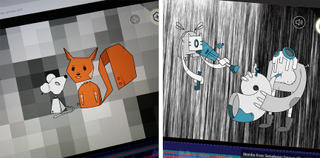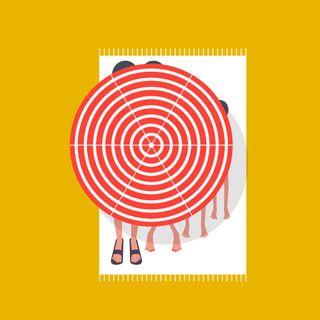Take your freelance career to the next level
How to tackle the three key stages of freelance life and thrive as a freelance designer or illustrator.
Level two: Build your freelance career
Freelancing is a constant process of hustle and flow, which means the need for self-promotion and reinvention never stops. For Stina Jones, a freelance graphic designer and illustrator based in Manchester, UK, this meant working out how to promote both skillsets in one coherent way.
"The challenge for me was striking the right balance and showcasing a little bit of everything without spreading myself too thinly," she says.
"There's a degree of crossover between the disciplines, though. In more recent years, I've found using a mix of skills has become second nature on a lot of the projects I undertake, which in turn has made it easier to bring these different skillsets together in one portfolio."
Jones says one of the most important lessons she has learned during her time as a freelancer is the importance of simply being herself. "When I started out as a freelancer, I spent a lot of time trying to present myself as being all things to all people, which made it take longer than it could have to find my niche and create a sustainable and enjoyable work environment for myself," she reflects.
Don't neglect personal projects
"I also wish I'd known the value of spending time on personal projects, over doing free work for others in the hope of a bit of exposure," adds Jones.

"Personal projects help you to expand your vision and skills, and you also find yourself doing work that you wouldn't usually do as a commission," agrees Pol Solsona.
"Besides that, I try to add something new to any project because I think it's not fun to repeat the same pattern over and over. I also keep myself culturally updated by visiting local art exhibitions and events."
Get the Creative Bloq Newsletter
Daily design news, reviews, how-tos and more, as picked by the editors.
Start networking
Jones points out that networking is also hugely valuable for freelancers, which includes strengthening links with each other. "Don't disregard building relationships with other freelancers – they're not necessarily your competition. Collaborate on projects, share tips and advice, pass leads to each other and just generally be supportive of your fellow freelancers, as more often than not it's mutually beneficial."
Building relationships with other freelance creatives, whether it's online through blogs and social media, or in person via meet-ups and events, is also a good way to stave off potential loneliness.

Graphic designer Alex Fowkes agrees that freelancing can be isolating – something he didn't fully anticipate before he embarked on a solo career. "I didn't realise how difficult it would be to work alone when I first started," he says. "I craved working alone and wanted to do everything myself, whereas now I want to collaborate and work with other people."
"Now that I've established my own style and a portfolio, I crave collaboration with people who have different skills who can push me. Trying to do that in the real world is difficult because client projects don't allow for it and you don't necessarily have the time to do it off your own back," he says.
Choose the right hours
Fowkes says that learning when he functions best has boosted his productivity. "I come up with ideas in the morning," he says. "If I need to fulfil them during the afternoon then that's okay, but I can't think of new ideas or finish something to a high level." He sits down to work around 7am. "I love looking at the clock at 10am, knowing that I've got rid of my worries for the day," he says.
"I think working 9–5 is going to be used less and less," he adds. He is about to take a working holiday to the French Alps, where he plans to divide his time between freelance work and leisure pursuits.
"Freelancers sometimes think they have to sit at their desks from 9am, but before or after that is when they actually get their best work done – either before the client is in, or after they leave. What matters is that you're on top of it."

This flexibility to work whenever and wherever you want is one of the great draws of freelancing, yet you can easily forget to make the most of it. "You need to embrace the fact that you are your own boss," says MJ Jackson.
"If you want to take advantage of the sunshine, then get out there. Just remember that you might have to make yourself work late to catch up," he advises. "Don't be afraid of leaving your bedroom desk to work in libraries or coffee shops. You need to interact with the outside world and get inspired, and if you're working from home then you can miss out on that."
Don't put too much pressure on yourself
The pressure of taking full responsibility for your own business and livelihood can feel relentless at times. "Trusting my own ability as a pen and an imagination for hire seems to put a lot more pressure on me than being a permanent member of a studio," Jackson says.
"Perhaps it's the feeling that you have to deliver to justify the fee, but there's no need to put that amount of pressure on yourself." After all, he explains, design is usually a collaborative process, "and you've been commissioned because they like you and your work."
It's important to remember that existing clients can be one of your best sources of future work. Repeat business will potentially arise from successful projects, says Jackson, "so keep your standards high and do your best work. Make yourself invaluable. If you're choosing the right clients and enjoying the work, then you're more likely to be producing good stuff."
Next page: Level three: become a freelance star

Thank you for reading 5 articles this month* Join now for unlimited access
Enjoy your first month for just £1 / $1 / €1
*Read 5 free articles per month without a subscription

Join now for unlimited access
Try first month for just £1 / $1 / €1
Current page: Level two: build your freelance career
Prev Page Level one: get started as a freelancer Next Page Level three: become a freelance star